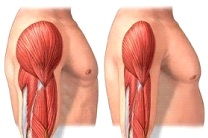Polymyositis Symptoms, Causes, Diagnosis and Treatment

What Is Polymyositis?
Polymyositis is a rare inflammatory ailment which causes weakness in muscle has influences on both parts of your body. It is able to create it hard and challenging for you to get up from a sitting position, climb stairs, reach overhead or lift objects.
The disease Polymyositis normally has an influence on adults when they are in the age of 30s, 40s or 50s. Rather than whites it is extra common in blacks, and as compared to men, women are affected by polymyositis frequently. Symptoms and signs of Polymyositis generally develop slowly, within weeks or a month maybe.
What Are The Symptoms Of Polymyositis?
The weakness in muscle related with polymyositis includes the muscles contiguous to the trunk, for instance, those in your upper arms, shoulders, thighs, neck, and hips. The effects of weakness will be on both the right and left part of your body, and be likely to slowly worsen.
It is a general ailment; it shows that it has impact on your complete body. Tenderness and weakness of Muscle might be the symptoms of polymyositis.
Following are the Common symptoms of polymyositis:
- Trouble swallowing.
- Pain in muscle.
- Weakness of Muscle in the hips, and shoulders this is able to sort it difficult to lift your arms above the head, climb stairs or stand from a sitting position.
- Because of weak throat muscles Difficulties in voice.
- Reduction in breath
There will be more symptoms of Polymyositis which includes:
- Reduction in Weight.
- Morning, stiffness.
- Tiredness.
- Pain in Joints.
- Fever.
- Loss of hunger.
What Are The Causes Of Polymyositis?
The skeletal muscles are affected by the Polymyositis. It’s as well recognized as idiopathic inflammatory myopathy. However the particular cause is unidentified, nevertheless it possibly will be associated to an infection or autoimmune reaction.
At any age, this particular disease is able to affect individuals. It is extremely common in children ages around 5 – 15 and the adults that age between 50 and 70. As compared to men, twice it affects women. Polymyositis is very common in Americans or African.
How Polymyositis Is Treated?
Medication is the key treatment for polymyositis. Corticosteroid medicines for instance prednisone are used on a frequent basis. Usually, these medicines are provided in high amounts and also contain an influential anti-inflammatory effect. Medicines which neutralize the defenses of the body against infections are frequently utilized in mixture with the corticosteroids. For instance, the immunosuppressive medicines contain cyclosporine and azathioprine. NSAID’s (Non-steroidal anti-inflammatory) medications for instance diclofenac possibly will be suggested to treat any discomfort and pain.
How Polymyositis Is Diagnosed?
The diagnosis of polymyositis isn’t easy. The symptoms of it change from one to another. It’s habitually a material of prevention of different conditions and diseases. The doctor will probably ask regarding your medical history and symptoms. There will be physical examination performed.
Following are the Tests which might be included:
- Blood tests for checking high muscle autoimmune and enzymes antibodies.
- EMG (Electromyogram) to evaluate activities of muscles.
- Biopsy of Muscle.
With the help of MRI, imaging test will take images of internal structures of your body to try to find the muscle inflammation.
What Are the risk factors of Polymyositis?
The particular disease is frequently seen in people aging from 31 to60 years old and in women. People suffering from polymyositis are likely to have a greater risk for worse results with old age.
By : Natural Health News




